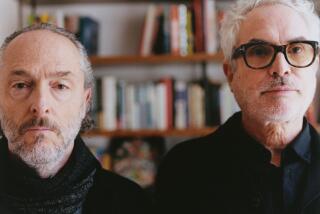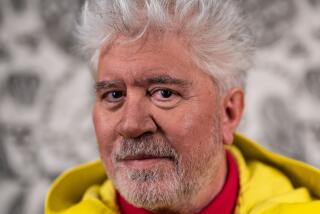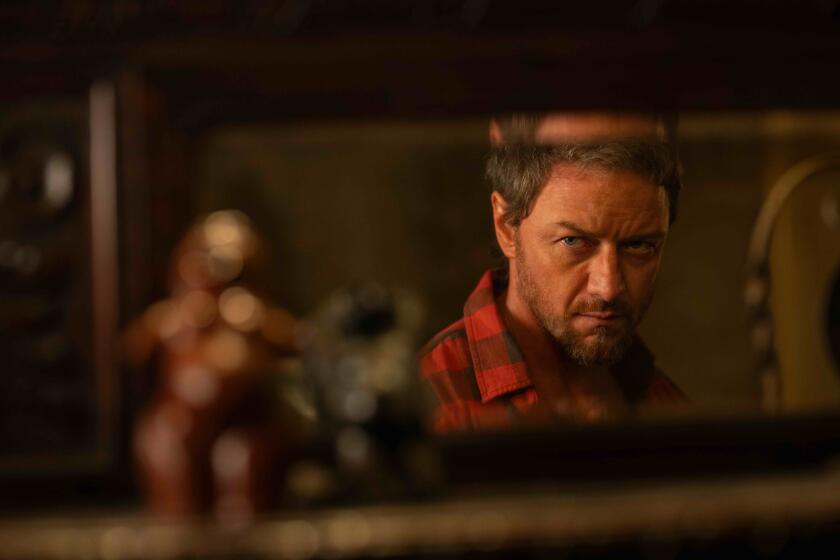The Indie Icon
John Sayles calls himself a screenwriter for hire. That’s what he does for a living. Between assignments, though, he has become America’s most celebrated independent filmmaker.
In the 20 years since his auspicious debut, “Return of the Secaucus Seven,” Sayles has written and directed 11 films, including “Matewan,” “City of Hope” and “Eight Men Out.” His screenplays for “Passion Fish” and “Lone Star” both garnered Academy Award nominations.
His latest film, “Hombres Armados (Men With Guns),” is in Spanish and takes place in a fictional Latin American country. Sayles learned the language while researching his 1991 novel “Los Gusanos,” and he wrote the first draft of “Men With Guns” in Spanish. The $2.5-million film, which opens Friday, was shot in Mexico, including in the politically charged state of Chiapas.
The story follows Dr. Fuentes (Argentine actor Federico Luppi) as he tracks down the medical students he trained to work in remote mountain villages. Far from the familiar capital city, the doctor comes face to face with the many victims of a civil war he formerly had been able to ignore.
Sayles’ movies are often politically minded and always low-budget. Since he gets non-studio financing--including $1 million of his own money for “Men With Guns”--he has complete control over every aspect of production. He estimates that he has made all 11 of his films for about $30 million.
Sayles, 47, continues to work as an actor, script doctor and screenwriter for hire. Currently, he’s working with James Cameron on adapting a novel called “Brother Termite.” Sayles and Maggie Renzi--his companion of 20-plus years and producer of most of his films--split their time between Hoboken, N.J., and upstate New York.
Question: Why was it crucial to make this film in Spanish?
Answer: There was never any question in my mind that it was not going to be in English. The story really has so much to do with a guy [Dr. Fuentes] who wanders outside the capital city and realizes that, “Wait a minute, people don’t even speak my language, and I’m still in my own country.”
Also there’s a point to be made that language is not culture. So even though the doctor doesn’t speak the language of the American tourists, he actually has more in common with them than he does with these other people he keeps running into who are indigenous, who don’t have a Western point of view.
Q: There are actually five languages spoken in the film. How did you work on the set?
A: The thing is, if you’re the director and you know what you want to say, there’s a limited vocabulary. So I worked in Spanish with everybody on the set, except the director of photography, who’s Polish. He had an interpreter to work with his crew, but they were speaking lighting, which is its own language.
There’s two or three Mayan languages--Tzotzil and Maya--and there’s Kuna, which is spoken on an island off the coast of Panama. The deserter’s character is speaking Nahuatl, which is the Aztec language. And then there’s the English that the tourists are speaking.
Within the movie, I just wanted those moments where the doctor was frustrated because he didn’t know what they were saying and they didn’t speak his dominant cultural language.
The guys in the village who sacrifice themselves, their first language was Tzotzil, and their second language was Spanish. So I worked with them in Spanish and they would translate the dialogue into Tzotzil. So I would talk to them and say “Guys, I’m trusting you, if you mess up with the lines, tell me.”
Q: Many of your films are talkative--but the language in “Men With Guns” is very sparse. Is that a result of writing in a foreign language?
A: It’s written in subtitles. . . . My main problem with subtitled movies--and this is a movie that will be subtitled in every country in the world--is that you feel like you’re missing things. The rule, basically, is you can have 36 characters including spaces per line, two lines per screen. If you’re not going to start losing a lot of the dialogue--which frustrates the audience--that predicates a certain kind of rhythm. The rhythm of this particular film . . . is sort of like a Catholic catechism. “What is faith?” “Faith is this. . . .”
Q: You filmed in Chiapas and the story seems inspired by the Guatemalan civil war. Why did you set the movie in a fictional country?
A: The original story of the doctor I got from a novelist, Francisco Goldman, who’s part Guatemalan and whose uncle was a doctor in Guatemala City--of course, not as ignorant or innocent as the guy in the film. But he didn’t think the government would go as far as they did and they ended up killing a lot of his students, almost all of them.
But many of the incidents in the film are taken from places not even in Latin America. Some of them are taken from Bosnia, some are based on incidents in the former Soviet Union, some of them based on things that happened in Vietnam.
There’s a speech that the doctor’s son-in-law gives at the beginning, where he’s saying, “Our family’s lived with these people for centuries. You don’t know what they’re like.” Although I heard that often in Latin America, it’s pretty much verbatim what I heard in Georgia during the civil rights movement.
I gave the film a very generic title for a reason, because I think this is a story and theme that goes beyond ideology. You’re in a village, and somebody comes and they’ve got guns. They say four of your sons are coming with us and they’re going to be on our side in the fight against the evil people. Here are some flags and signs, and you’re on our side now. A week later, it’s the other people who come, and they take four kids to be on their side and say, “We’re going to punish whoever cooperated with our enemy.”
And there you are, just trying to raise your crops and raise your children. It isn’t about left and right anymore. It’s just: “Please let them not come anymore.”
Q: The Americans, played by Mandy Patinkin and Kathryn Grody, are the Teflon tourists, unscathed by what is happening right around them. Still, they know more about the country than Dr. Fuentes.
A: Intellectually, they do. They come from a place with a freer press.
Two of my favorite movies about Latin America are “Under Fire” and “Missing.” But they both, because of how they were financed, suffer from what I think of as the “if a tree falls in the woods and it doesn’t hit an American, it didn’t fall” syndrome.
For Americans, the tourists may seem like comic relief. We can see how bad their Spanish is. We can kind of identify with them. In a larger sense, though, my point in having them there is that they are the same class as Dr. Fuentes. They have this parallel journey with him, going, geographically, to all the same places. Every time they cross paths, though, they are the same and he’s different. They’re not emotionally involved.
The doctor’s self-image is not the same. He knows some of his students have been killed and he’s partly responsible for not knowing enough about where he was sending them. . . . He’s somebody who’s guilty, I think, of willful ignorance.
Q: Did you have any interactions with the army or Zapatistas?
A: Because of the tensions in the country, any time there were guns in a scene, those guns came out of a prop house in Mexico City, went straight to a military detachment, were brought to the set . . . in a crate, unsealed, serial numbers taken down by the army. We used them for the day, gave them back to the army, they put them back in the crate and sealed it.
They didn’t want us carrying guns that could be converted--or even guns that could be faked as real guns--out into the country and selling them or saying they got lost. We also had to get a license to have camouflage uniforms because you can’t sell those in Mexico either.
Q: Your movies always immerse filmgoers in a setting. What do you do to make that so complete?
A: You really try to choose your locations so they’re telling a story. That’s why we shot all over Mexico instead of one little area. If I had more money I probably would have shot in four different countries.
Then, I have a philosophy of writing where I do as much research as I can. First reading research, but usually also a trip to the place to talk to the people. Then in pre-production, we’ll show the script to the people we’re going to be working with, the people who are going to be in it and who it’s about. And we say, does this seem right? And the final thing we do is we try to cast as many of the small parts as we can locally. So in “Lone Star,” we probably had 25 actors from Texas.
Q: You also always seem to work with well-known cinematographers, including Slawomir Idziak [“Gattaca,” “Blue”] on this film.
A: You know, we didn’t get along on this at all. It’s interesting, because I think the movie looks good, but it’s not the way I wanted it to look or the way he wanted it to look. But when you start with talent, even if the working experience doesn’t work out perfectly, you still get something watchable and it can look beautiful.
In Mexico, the problem is that it’s very hard, hard white light, which is the cinematographer’s nightmare. Idziak’s style is very filtered, shooting stuff that looks like you’re in an Eastern European country that has a lot of smoke in the sky filtering things naturally. Our fights were often about how hard the light could be and how much it could invade the frame.
Q: Younger independent filmmakers are always saying that they want to be like John Sayles.
A: That rarely means they want to make movies like me. It means they’d like to continue making movies and controlling them. I think even people who work in the studio system would like that, just to get to make a movie every couple of years and have control over it. Wouldn’t we all?
But I don’t see any huge evidence that our movies have been that influential in terms of what the movies are about. I see a couple dozen independent--or so-called independent or low-budget movies--every couple years. And there are some things that Hollywood isn’t dealing with, but an awful lot of them are, “Here’s my audition piece to be a Hollywood filmmaker.”
But I do think the fact that we’ve been able to now make 11 movies--mostly outside the mainstream, all of which had a theatrical release--and then keep coming back and doing it, is great. It’s something people can aim at.
Q: Has the growth in the independent film market affected your work?
A: It has in a way. There are more screens to play on, so that if you have a movie that has a little momentum, you can get it out more broadly. When we first started, there wasn’t an art screen in Dallas. So our penetration is a little better because of the phenomenon.
But the increasing volume of movies getting made and attempting to get theatrical exhibition every year kind of hurt us, in that there’s more competition. There are X number of screens and 52 weeks in the year. That’s your finite universe. And now you’ve got 700 movies trying to get on those instead of 12.
Q: Would you know what to do with a $40-million budget--which is about average for a Hollywood movie?
A: If you look at that $40 million, they probably had $8 million to actually make the movie after you take out everything “above the line”--which we usually don’t pay. I often don’t pay myself as director. I pay myself scale as a writer because I’m in the Writers Guild. And then I’m a profit participant if the movie makes a profit. Our producers take chump change compared to most producers. We have fewer producers, too. We don’t have 15 guys taking a half-million to a million dollars off the top. And the actors don’t get their usual price, especially if we’re doing an ensemble piece.
Usually I feel that the investors have a very good chance of getting half or more of their money back, a good chance of making their money back, and some chance of making a profit. What they don’t have, generally, is a huge upside. This is not a movie--”Men With Guns”--that’s going to turn into “The Full Monty.”
So, if I had $40 million, what I would do is make something like a $20-million movie and pay everyone really well in reward for all the times they didn’t get paid that well.
More to Read
Only good movies
Get the Indie Focus newsletter, Mark Olsen's weekly guide to the world of cinema.
You may occasionally receive promotional content from the Los Angeles Times.










